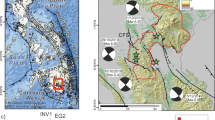Abstract
Despite our understanding of the different mechanisms of man-made earthquakes, their short-term prediction and prevention is yet to be attained. In the present study, we propose an integrated four-step approach to predict and prevent man-made earthquakes or reduce their chance of occurrence. Our four-step approach includes locating the highly anomalous zones of microseismic emission (MSE) that result from the stress-deformed state inside a geological formation and often represents the “seismic nuclei” for impending earthquakes, monitoring the variations and dynamics of the anomalous MSE zones over a period of one lunar month, inducing a creep-discharging of the MSE zones using a vibroseis seismic source at the ground surface, and monitoring the same MSE zones following the creep-discharge to determine whether the stress-deformed state was released and the chance of potential earthquake occurrence has been eliminated or reduced. The proposed full four-step approach has never implemented at one single location. Nevertheless, these steps have been tested separately at different sites and have proven successful. We propose conducting the full four-step approach at various locations of potential man-made earthquake activities around the world including the state of Oklahoma in the USA.
Access this article
We’re sorry, something doesn't seem to be working properly.
Please try refreshing the page. If that doesn't work, please contact support so we can address the problem.







Similar content being viewed by others
References
Bolt BA (1978) Earthquakes: a primer
Chirkin IA, Rizanov EG, Kalyashin SV, Koligaev SO, Radwan AA (2014a) Monitoring of microseismic emission for supporting the ecological safety in exploration and development of oil fields in water areas. Bulletin of the Russian Academy of Natural Sciences 4:8–14 (in Russian)
Chirkin IA, Rizanov EG, Koligaev SO (2014b) Monitoring of microseismic emission – a new trend in the development of seismic exploration. Instrum Sys for Geophys Explor 3:6–15 (in Russian)
Frohlich C, DeShon H, Stump B, Hayward C, Hornbach M, Walter JI (2016) A historical review of induced earthquakes in Texas. Seismological Res Lett 87(4):1022–1038
Hseih P, Bredehoeft J (1981) A reservoir analysis of the Denver earthquakes: a case of induced seismicity. Journal of Geophysical Research: Solid Earth 86(B2):903–920
Hough SE, Page M (2015) A century of induced earthquakes in Oklahoma? Bull Seismological Soc America 105(6):2863–2870
Karamanos AS (1993) Earthquake prediction from the viewpoint of earthquake engineering. In: Prediction and perception of natural hazards. Springer, Dordrecht, pp 135–142
Kasahara K (1981) Earthquake mechanics. Cambridge: Cambridge University Press
Kouznetsov OL, Lyasch YF, Chirkin IA, Rizanov EG, LeRoy SD, Koligaev SO (2016) Long-term monitoring of microseismic emissions: Earth tides, fracture distribution, and fluid content. Interpretation 4(2):T191–T204
Kuznetsov OL, Chirkin IA, Kuryanov YA, Rogotsky GV, Dyblenko VP (2004) Experimental studies, vol 2. In: Seismo-acoustics of porous and fractured geological formations, vol 1-3, Moscow, State Research Center of Russian Federation VNIIGEOSYSTEM, p 362 (in Russian)
Kuznetsov OL, Chirkin IA, Kuryanov YA, Slionkin SI (2007) New technologies and solution of applied problems, Vol 3. In: Seismo-acoustics of porous and fractured geological formations, vol 1-3, Moscow, Center of Information technologies and nature use, LLC, p 434 (in Russian)
Llenos AL, Michael AJ (2013) Modeling earthquake rate changes in Oklahoma and Arkansas: possible signatures of induced seismicity. Bulletin of the Seismological Society of America 2850–2861. https://doi.org/10.1785/0120130017
McGarr A, Simpson D, Seeber L, Lee W (2002) Case histories of induced and triggered seismicity. Int Geophys Series 81(A):647–664
McNamara DE, Rubinstein JL, Myers E, Smoczyk G, Benz HM, Williams RA, Hayes G, Wilson D, Herrmann R, McMahon ND, Aster RC (2015a) Efforts to monitor and characterize the recent increasing seismicity in central Oklahoma. Lead Edge 34(6):628–639
McNamara DE, Benz HM, Herrmann RB, Bergman EA, Earle P, Holland A, Baldwin R, Gassner A (2015b) Earthquake hypocenters and focal mechanisms in central Oklahoma reveal a complex system of reactivated subsurface strike‐slip faulting. Geophys Res Lett 42(8):2742–2749
National Research Council (2003) Living on an active earth: perspectives on earthquake science. Washington, D.C., National Academy of Science, p 43
Nicholson C, Wesson RL (1990) Earthquake hazard associated with deep well injection: a report to the U.S. Environment Protection Agency, US Geological Survey Bulletin 1951, p 74
USGS (2018) Earthquakes in Oklahoma greater than or equal to magnitude 3.0 since 1978 (data provided by the Oklahoma Geological Survey and USGS-NEIC ComCat). Source: https://earthquake.usgs.gov/earthquakes/byregion/oklahoma/OK-M3-dec3-2018.pdf
Acknowledgements
Authors would like to thank the editor-in-chief, the guest editor, and the reviewers for the time and exertion they put into their constructive comments and remarks that really helped in improving the quality of the manuscript.
Author information
Authors and Affiliations
Corresponding author
Ethics declarations
Conflict of interest
The authors declare that they have no competing interests.
Additional information
This article is part of the Topical Collection on New Advances and Research Results on the Geology of Africa
Rights and permissions
About this article
Cite this article
Kuznetsov, O., Chirkin, I., Radwan, A.A. et al. Man-made earthquakes prevention through monitoring and discharging of their causative stress-deformed states. Arab J Geosci 14, 288 (2021). https://doi.org/10.1007/s12517-021-06646-x
Received:
Accepted:
Published:
DOI: https://doi.org/10.1007/s12517-021-06646-x




